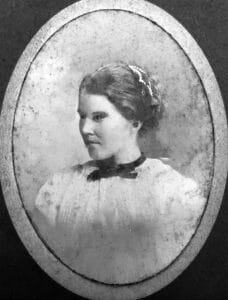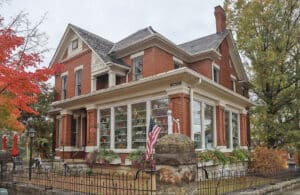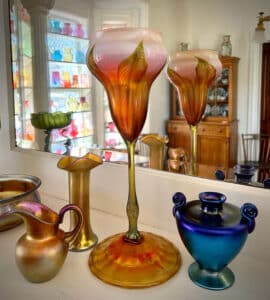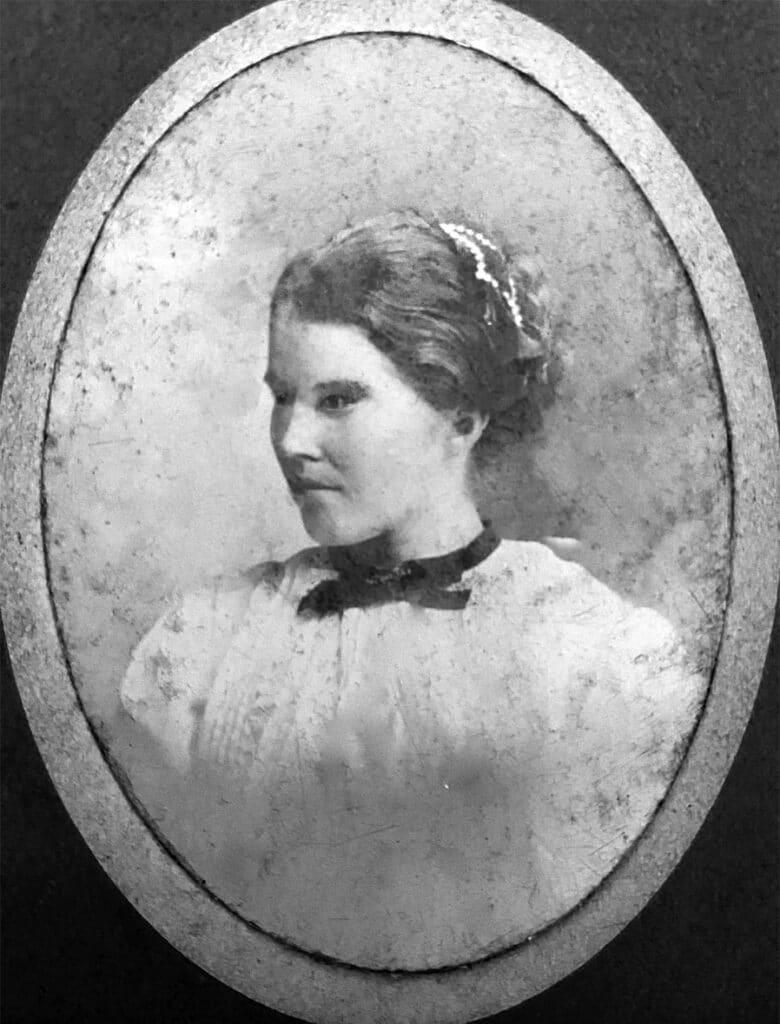“Always paddle your own canoe.”
– Anna Safley Houston

Nestled in a thriving art district in Chattanooga, Tennessee, the Houston Museum of Decorative Arts holds an internationally recognized collection of Victorian art glass and antiques. The museum is in a stately Victorian home holding more than 12,000 items from 12 different countries. There are at least 50 collections within the overall collection, each representing an aspect of Victorian life. From fine-blown and cut-glass water pitchers and decorative items—including works by Steuben, Tiffany, Durand, Loetz, and Fenton—to one-of-a-kind Tennessee-made furniture from the early 1800s, these objects teach visitors about history, beauty, manufacturing, function, and most importantly, they evoke nostalgia and curiosity.
This impressive collection is a testament to the skill and determination of one woman, Anna Safley Houston (1876–1951). That a woman of her time, a woman of modest means and little education, could amass such a significant collection and gift it to the people of Chattanooga establishes Anna as a one-of-a-kind patroness of the arts.
Anna was the first of 11 children born to an Evening Shade, Arkansas family. She left school after sixth grade to care for her siblings after the death of their mother in childbirth. She left home at 15, taking odd jobs including one as a hair model at medicine shows, and eventually, she landed work as a buyer of ladies’ clothing for Marshall Field in Chicago and Macy’s in New York. In 1897, she came south to Missouri and at 21 married her first of nine husbands, Otto C. Ashbaugh. They had two children, girls, who both died in infancy. Ashbaugh, however, was not there for the birth of the second child – he departed while Anna was pregnant. After the passing of her second child, Anna made a life for herself as an independent woman.
Anna came to Chattanooga in 1904 by way of California, after having married her third husband, E.R. Crisman. Using her money, Crisman invested in a furniture store, making her part owner. That husband soon moved on, but Anna stayed in Chattanooga for the rest of her life. There, Anna was known as a “pioneering female entrepreneur.” She owned a thriving ladies’ clothing store and milliner shop advertising “Fancy Scarves, Neck Wear, Drawn Work, and Holiday Goods.” She invested in real estate, purchasing rental property around town.
In 1920, Anna opened the Red Brick Dixie Antique Shop. Her interest in decorative arts, which began early in childhood when she would collect broken bits of glass and paste them on jars, came to fruition in the 1920s. She was a self-taught authority on the decorative arts; collectors, dealers, and publishers consulted her about art glass and antiques.

During the 1920s Anna developed a single-minded focus on collecting museum-worthy items, most of which she did not sell in her shop but kept in order to maintain the integrity of her growing collection. During her lifetime, she traveled to every state in the U.S. and extensively in Canada and Mexico, where she once dodged bullets exchanged between Pancho Villa and the U.S. Cavalry.
One of the unsolved mysteries about Anna’s life revolves around how she paid for her valuable collection. She made money from her successful businesses, and records show that she refinanced her property holdings regularly. There is some evidence that she purchased items at very low prices from people who did not have an idea of their value. And, she was known for some questionable business practices, like purchasing items COD during buying trips and then haggling with the freight office over price when the items arrived in Chattanooga.
Though she married and divorced many times, her husbands were not a source of funds. Several of them, however, did provide stability and services related to her businesses. Her favorite and longest-lasting marriage to plumber James W. Houston provided plumbing services for her rental properties, and he had a truck to transport items she purchased for the collection. One husband worked for the railroad, so she was able to travel cheaply by rail. And as a woman, she needed a husband to conduct business transactions!
During the Great Depression, Anna lost her businesses and properties. Over time she neglected her health to devote everything to the preservation and expansion of the collection. At the age of 60, with the help of one teenager, she built a large, barn-like warehouse with a tarpaper roof outside of town to house the collection, herself, and her beloved dog Sonny.
The barn had no heat or running water. Anna refused to spare money for food and healthcare, relying on friends for sustenance and occasionally allowing patrons into the barn to view and purchase from the collection. Mary Jean Giles Roberts, the daughter of one friend, described the interior of the barn as a jungle of antiques: “Furniture stacked on cartons and crates stacked on furniture lined the walls and ran down the center of the room. Glassware, china, and small items were arranged on every surface. The ceiling and upper walls were festooned with hundreds of pitchers and cups of all description.” Additions to the barn are evidence that Anna continued to collect priceless art glass and antiques even as she continued to neglect her own well-being.

Houston Museum
Of Anna’s focus on establishing a museum, Mary Jean Rogers noted that “Mrs. Houston was a woman of single-minded purpose. Time after time, she talked of the museum which would one day exist for her treasures. She would, and did, sacrifice everything for it.”
Anna Safley Houston died in 1951, having organized a nonprofit with a vision of sharing the collection and its history with future Chattanoogans. Before her death, she hired attorney Blaine Buchanan to establish the museum, with an astonishing 102 Trustees named in its charter. The museum opened in the Bluff View Art District in 1961 and moved into its permanent home in 1968.
Today the Houston Museum of Decorative Arts flourishes not just because of Anna Safely Houston’s astute, informed ability to collect museum-quality items, but also because of her single-minded focus on a vision of an arts education and enrichment space for the people of her adopted community.
Visit the Houston Museum at www.thehoustonmuseum.org for information about Houston Museum exhibits, events, and community activities, including the 50th Anniversary Antiques Show and Sale in February 2024.






Related posts: